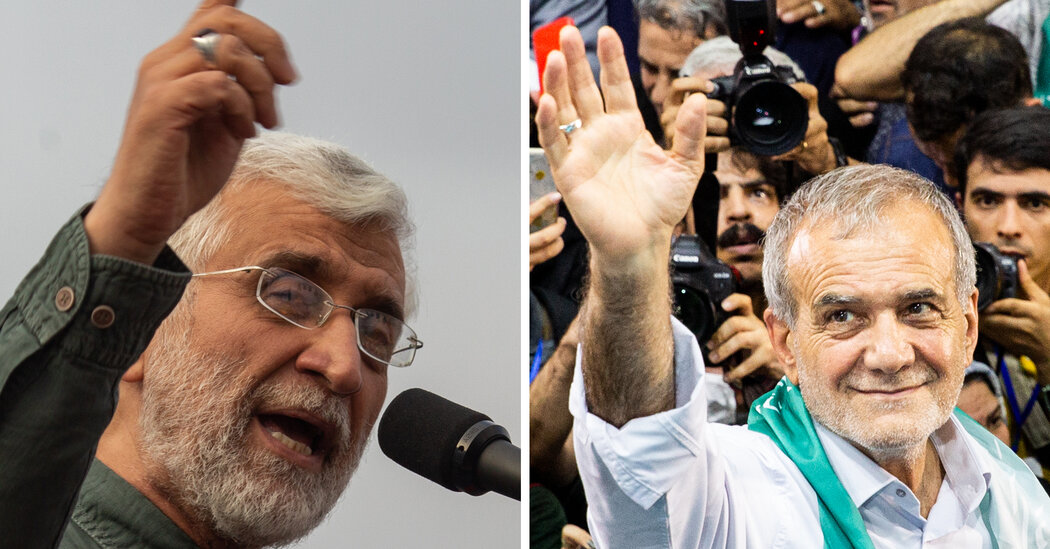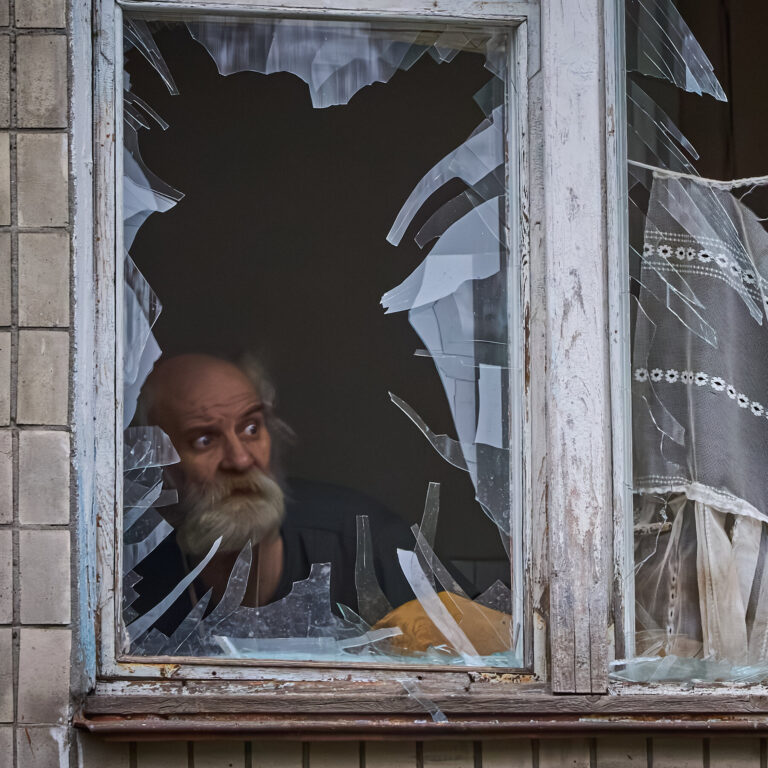A reformist candidate critical of many Iranian government policies, including the mandatory veil law, will compete next week against a hardline conservative in a runoff for the country's presidency, Iran's Interior Ministry announced Saturday. The runoff follows a special vote called after the death last month of the previous leader, Ebrahim Raisi, in a helicopter crash.
A second round of voting, pitting reformist Masoud Pezeshkian against Saeed Jalili, an ultra-conservative former nuclear negotiator, will take place on July 5. The runoff was partly the result of low voter turnout and a field of three major candidates, two of whom competed for the Conservative vote. Iranian law requires that a winner receive more than 50 percent of all votes cast.
A majority of Iranians, 60 percent, according to the Interior Ministry, did not vote on Friday, in what analysts and candidates’ aides said was largely an act of protest against the government for ignoring their demands for meaningful change.
A prominent Iranian economist, Siamak Ghassemi, said on social media that voters are sending a clear message. “In one of the most competitive presidential elections, where reformists and conservatives came out in force, a 60 percent majority of Iranians have decided to side with reformists and conservatives.”
Iran faces multiple challenges, from internal turmoil to international tensions. Its economy is collapsing under heavy Western sanctions, its citizens' freedoms are increasingly limited and its foreign policy is largely shaped by hard-line leaders.
The campaign, which initially included six candidates, five conservatives and one reformist, was notable for the frankness with which these topics were discussed and the public willingness to attack the status quo. In speeches, televised debates and roundtable discussions, candidates criticized government policies and ridiculed official rosy assessments of Iran's economic prospects as harmful illusions.
Public dissatisfaction with the ability of each new president to bring about change was reflected in dismal voter turnout, a historic low for a presidential election and even lower than the 41 percent level seen in parliamentary elections earlier this year. The low totals will be a blow to the country’s ruling clerics, who have made voter turnout an indicator of the perceived legitimacy of the vote and had hoped to achieve a 50 percent turnout.
In the official results announced on Saturday, Dr. Pezeshkian led with 10.4 million votes (42.4%), followed by Jalili with 9.4 million (38.6%). A third conservative candidate, Mohammad Baqer Ghalibaf, current speaker of the Parliament and former mayor of Tehran, ranks third with 3.3 million (13.8%).
It is not yet clear whether a runoff between two candidates representing different ends of the political spectrum will convince more voters to go to the polls, when large numbers of Iranians see the candidates as part of a system they want to reject altogether.
“This will be a very difficult and challenging week,” Mohammad Mobin, a Tehran-based analyst who worked on Dr. Pezeshkian's campaign, said on Saturday. “To get voters out we have to be strategic.” He added, speaking of the Conservatives: “People think there is no difference between us and them.”
Simple math would suggest that Mr. Jalili would get more than 50 percent if he picked up Mr. Ghailibaf’s votes. But in previous polls, many of those who voted for Mr. Ghalibaf said they would not support Mr. Jalili. And Dr. Pezeshkian may pick up votes from those who fear the prospect of a Jalili presidency.
On Saturday, in a neighborhood in northern Tehran, a group of men discussed the election results and the prospects of the runoff over coffee. One of them, Farzad Jafari, 36, expected a higher turnout in the next vote. He and others also debated whether Jalili would be able to unite the conservative vote in a head-to-head fight, or whether even more voters would emerge to support the reformist option offered by Dr. Pezeshkian.
Mr Jafari said he thought many of those who, like him, abstained from Friday's vote might well have been recalled for the runoff. “I didn't want to vote at all because they excluded those who should have been in the running, they were mostly reformers,” he said. “But more people will vote next time in the next round and those who cast a blank vote, or who did not vote, will come.”
In addition to domestic pressures, Iranian leaders also face a particularly volatile moment in the region: Israel's war in Gaza against Hamas, an Iranian-backed militant group, and escalating skirmishes between Israel and Hezbollah pit two of Iran's proxy forces against Israel, its sworn enemy.
Despite the campaign's critical rhetoric, the candidates were all members of Iran's political establishment, approved to run by a committee of Islamic clerics and jurists. All except one, Dr. Pezeshkian, were considered conservatives close to the country's supreme leader, Ayatollah Ali Khamenei.
Jalili, a former nuclear negotiator, is probably the closest candidate to Khamenei. He heads the far-right Paydari party and represents the country's most hardline ideological views when it comes to domestic and foreign policy. Jalili has said he does not believe Iran needs to negotiate with the United States to achieve economic success.
Dr. Pezeshkian is a heart surgeon and Iran-Iraq War veteran who served in Parliament and as Iran's health minister. After his wife died in a car accident, he raised his other children as a single father and never remarried. This and his identity as an Azeri, one of Iran's ethnic minorities, endeared him to many voters.
Dr Pezeshkian was backed by a reformist former president, Mohammad Khatami, and expressed openness to nuclear negotiations with the West, framing the debate as an economic issue with the ultimate goal of escaping economic sanctions for its nuclear and ballistic missile programs.
After a heated public dispute, Mr Ghalibaf issued a statement on Saturday supporting Mr Jalili and calling on his voters to do the same to ensure victory for the conservative camp.
By stacking the deck to increase a conservative's chances of victory, Khamenei signaled his desire for a second-in-command whose vision mirrored his own and who would advance Raisi's hardline agenda.
The low turnout reflects widespread apathy among Iranians, whose frustration has been compounded by the government's violent crackdown on protesters demanding change and its inadequate response to the toll that decades of sanctions have taken on the country's economy, reducing Iranians' purchasing power.
The most recent anti-government demonstrations – and the resulting crackdown – were largely sparked by the 2022 death of Mahsa Amini, who died in police custody after being detained for incorrectly wearing the mandatory headscarf, or hijab.
In a nod to the unpopularity of the hijab law, all candidates sought to distance themselves from the methods used by the country's morality police to enforce it, including violence, arrests and fines.
While a new president might soften enforcement of the headscarf mandate, as Khatami and a moderate president, Hassan Rouhani, did during their terms, it is unlikely that the law will be overturned.
This is largely due to the fact that Iran is a theocracy with parallel systems of government, in which elected bodies are overseen by appointed councils made up of Islamic clerics and jurists. And the main state policies in nuclear, military and foreign affairs are decided by the country's supreme leader, Khamenei.
The president's role is focused on domestic politics and economic issues, but it is still an influential position. Mr. Rouhani, for example, played an active role in crafting the 2015 deal with Western powers in which Iran agreed to reduce its nuclear program in exchange for easing sanctions.
The Trump administration withdrew the U.S. from that deal in 2018, and Iran has since returned to enriching uranium. Aside from tensions over Tehran’s nuclear program, the U.S. and Iran have moved closer to direct confrontation in recent years as they compete for influence across the Middle East.
In Gaza, the war between U.S. ally Israel and Hamas has drawn the United States, Iran and its foreign proxies into a closer conflict. Iran sees the use of these groups as a way to extend its power, but many citizens, particularly in the cities, see little value in their leaders' strategy and believe the economy will recover only through sustained diplomacy and the lifting of sanctions. “We are in a Third World country and we are sitting on top of so much wealth,” said Vahid Arafati, 38, a bar owner in Tehran, after voting on Friday. “For example, the Arab states are benefiting from their wealth, but with our policy we can't achieve anything.”
When asked why he voted if he didn't expect big changes, he replied: “Maybe I have a little hope.” After a pause, he added, “Isn't it nice to have a little hope?”
Leily Nikounazar contributed reporting.





